Sikorsky Aviation History
The Design Evolution of the VS-300 Helicopter
by Steve Mendrzychowski
The VS-300 helicopter was designed as a research vehicle that was modified iteratively based on flight test results. Although the VS-300 is described as having four different configurations, it was in fact modified each night through the following morning by Igor Sikorsky and the VS-300 team after they completed a day of flight testing, analyzed the results and discussed design improvements. By the end of the VS-300 development program, only the pilot seat, main landing gear wheels, main transmission box and central fuselage framework remained from the original VS-300 helicopter’s design.
Timeline of the VS-300 Configurations
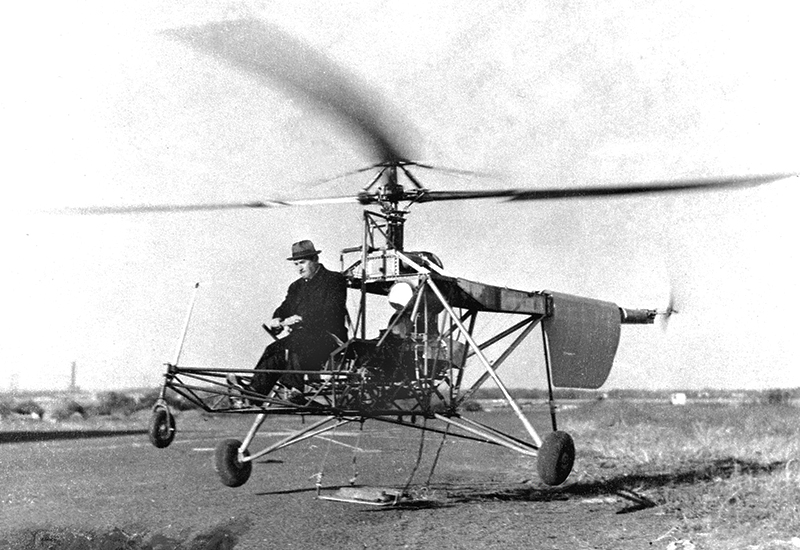
First Flight Configuration
- Canted Main Struts
- 4 Wheel Landing Gear
- Full Cyclic Pitch Control
- Single Tail Rotor Pedal
- Short Main Rotor Shaft
- Monocoque Sheet Metal Box Style Tail Boom
- Vertical Tail Fin
- Single Blade Tail Rotor
- Collective Wheel on right side

Modified First Configuration
- Full Swiveling Vertical Main Landing with Gear Oleo Struts
- T-bar Horizon Reference
- Dampers in Flapping Hinge
- Collective Pitch Stick on left side
- Dual Tail Rotor Pedals

Second Configuration
- Cyclic control removed from Main Rotor
- Collective control remained
- 2 horizontal rotors mounted on flat outriggers for pitch and roll control
- Canted Mail Landing Gear from original design reinstalled
- Tail skids replaced nose and tail wheels
- Tubular rear fuselage added for strength and ease of modification

Strengthened Second Configuration
- Outriggers strengthened with tubular structure
- 2 blades used on all three tail rotors

Amphibious Second Configuration
- Short Rubber Main Floats
- Tail Float
- Basketball Nose Bumper

Third Configuration
- Single horizontal tail rotor for pitch control
- Lateral Azimuthal Control restored to main rotor
- Longer Main Rotor Shaft

Final VS-300A Configuration
- Round Fabric nose and single sheet of fabric on rear fuselage
- Full Azimuthal control (Lateral and Pitch restored to main rotor
- Hydraulic Dampers on lead-lag of main rotor blades
First Configuration
The first configuration of the VS-300, which was initially designated the VS-1, included a 28-foot diameter main rotor, a 40-inch single blade tail rotor and a 75 hp Lycoming engine. For flight controls, it featured full cyclic main rotor control (pitch and roll) and a single pedal tail rotor control (yaw). Vertical control was provided by a large wheel to the right of the pilot. With Igor Sikorsky as test pilot, the first flight of the VS-300 occurred on September 14, 1939 lasting approximately 10 seconds and achieving a height of only a few inches. For safety reasons, the helicopter was tethered by four cables to a heavy plate, which allowed the helicopter to move in all directions by dragging the plate. A ground crew was present to stabilize the helicopter and prevent a roll-over if Igor Sikorsky lost control.
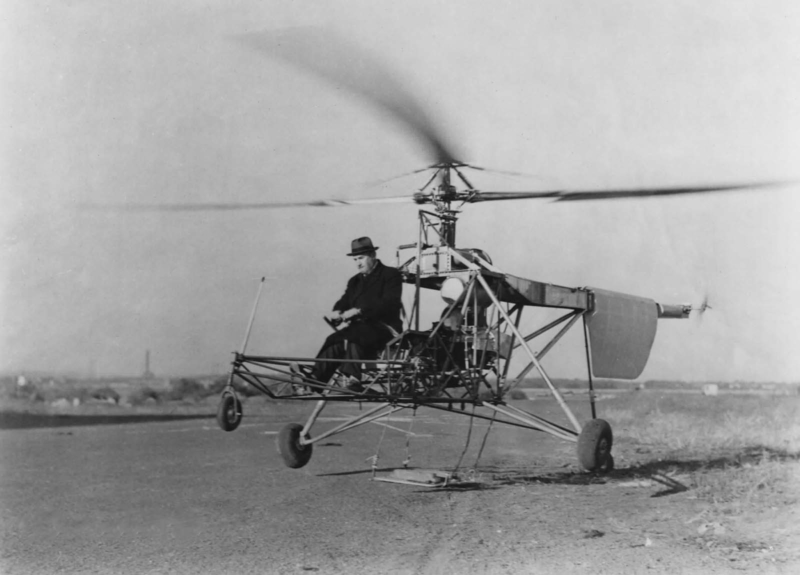 The first flight of the VS-300 helicopter on September 14, 1939.
The first flight of the VS-300 helicopter on September 14, 1939. The VS-300 helicopter on the morning of its first flight, September 14, 1939.
The VS-300 helicopter on the morning of its first flight, September 14, 1939. The VS-300 helicopter in the hangar on September 9, 1939, one week before its first flight. Note the tail of the XPBS-1 “Flying Dreadnought” (a.k.a., the Sikorsky S-44) in the background.
The VS-300 helicopter in the hangar on September 9, 1939, one week before its first flight. Note the tail of the XPBS-1 “Flying Dreadnought” (a.k.a., the Sikorsky S-44) in the background.
The initial test pilots of the VS-300, Igor Sikorsky and Serge Gluhareff, were truly pioneers, receiving on-the-job training by learning a little more about the aircraft with each test flight. As the pilots became more comfortable with flying the aircraft, they soon discovered that they could maneuver the aircraft in any direction of horizontal flight except forward. Their attempts to fly forward resulted in severe vibration and loss of control. Also, Igor Sikorsky and the VS-300 team did not understand yet why the VS-300 rolled to the left whenever the cyclic stick was pushed forward. They would later discover that rotor blades spinning around an articulated rotor head exhibit a phenomenon called control precession, which requires a control input of around 90 degrees rotation prior to where the control input is actually required.
At the time however, Igor Sikorsky and the VS-300 team had no idea whether the control problems were caused by the helicopter design or pilot technique.
Following each day of flight testing the VS-300, Igor Sikorsky and the team spent evenings through the next morning analyzing the results, discussing improvements and making adjustments to the aircraft. This was evident from Igor Sikorsky’s very detailed design notebooks from the VS-300 development, which include date and timestamps for each entry. Obvious changes to the VS-300 first configuration aircraft since the first flight were a new outrigger main landing gear with full swiveling wheels, the tail wheel was moved aft, and dampers were added to the flapping hinge on the main rotor to reduce vibration.
Test flights of the VS-300 first configuration continued over the next few months, with each flight lasting a little longer than the last, until December 9, 1939 when it was destroyed in an accident. Serge Gluhareff was making a slow forward flight in the VS-300 when a sudden gust of wind coming from around one of the hangars flipped it sideways, grinding the rotors into the asphalt pavement. Serge Gluhareff was unhurt, but the VS-300 first configuration suffered major damage and needed to be rebuilt.
Following the accident, the VS-300 team convened and Igor Sikorsky reminded everyone that the VS-300 was a flying test bed meant to experiment with rotor systems and flight controls. After analyzing the cause of the accident, the team agreed it was caused by the aircraft’s full cyclic pitch arrangement only allowing marginal control of the aircraft.
Second Configuration
The VS-300 was completely redesigned and rebuilt based on an early 1930 design by “Prof” Sikorsky, a draftsman, mathematician and cousin of Igor Sikorsky. In this second configuration, the VS-300 team removed the problematic cyclic pitch control of the first configuration and added two horizontal single-blade 40-inch diameter tail rotors located on laterally-placed outriggers. Only the collective pitch control for vertical flight was left unchanged on the main rotor from the first configuration. In addition to the outrigger-mounted horizontal rotors, changes to the VS-300’s tail included a redesigned triangular welded tube tail structure, a metal tail skid and a third tail rotor mounted vertically to provide anti-torque. In the cockpit, the pilot control stick that provided cyclic pitch in the first configuration VS-300 now provided longitudinal and lateral control through a mixer located behind the pilot’s seat. Also, the pilot control stick location was moved from the pilot’s right side to the left side.
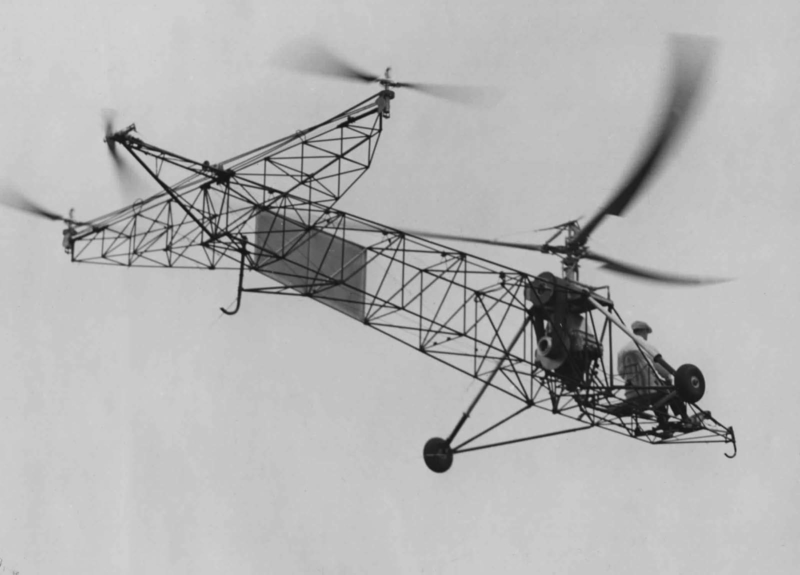 The second VS-300 configuration. Note the second configurations tail structure with two outrigger-mounted horizontal rotors and a single, vertical anti-torque rotor.
The second VS-300 configuration. Note the second configurations tail structure with two outrigger-mounted horizontal rotors and a single, vertical anti-torque rotor. The second VS-300 configuration on the factory tarmac, September 10, 1940.
The second VS-300 configuration on the factory tarmac, September 10, 1940. On May 20, 1940, the VS-300 was rolled out for its first public demonstration. At the completion, the State of Connecticut’s Commissioner of Aviation, Charles Lester Morris, presented Igor Sikorsky with Connecticut Helicopter License #1.
On May 20, 1940, the VS-300 was rolled out for its first public demonstration. At the completion, the State of Connecticut’s Commissioner of Aviation, Charles Lester Morris, presented Igor Sikorsky with Connecticut Helicopter License #1. Captain H. Franklin Gregory at the controls of the VS-300. Captain Gregory was a staunch supporter Igor Sikorsky’s helicopter, recognizing its potential early in development.
Captain H. Franklin Gregory at the controls of the VS-300. Captain Gregory was a staunch supporter Igor Sikorsky’s helicopter, recognizing its potential early in development. A rare color photo of Igor Sikorsky in the VS-300 hovering over meadow across from the factory.
A rare color photo of Igor Sikorsky in the VS-300 hovering over meadow across from the factory.
The first tethered flight of the second configuration VS-300 occurred on March 6, 1940 and continued for several weeks as the pilots familiarized themselves with the new flight controls. On May 13, 1940, the tether was removed and Igor Sikorsky performed the first free flight of the second configuration, noting an immediate increase in the aircraft’s performance over the first configuration. While control of the aircraft was greatly improved, forward flight was still a problem.
On May 20, 1940, Igor Sikorsky and the VS-300 team held the first public demonstration of the VS-300 at the Bridgeport Airport in Stratford, Connecticut. Guests included United Aircraft executives, local politicians, national media, and the Commissioner of Aviation for the State of Connecticut, Charles Lester Morris. With Igor Sikorsky at the controls, the VS-300 demonstrated several maneuvers including hovering, figure eights and pedal turns. Following the demonstration, Commissioner Morris presented Igor Sikorsky with Connecticut Helicopter Pilot’s License #1.
Between May 1940 and early 1941, the VS-300 team worked around the clock, flight testing during the day and making adjustments to the aircraft at night. Upgrades, including a 100 hp Franklin engine and 92-inch two-blade horizontal tail rotors, resulted in a significant increase in power and responsiveness. In another important modification, the tail rotors were spread by two feet and raised two feet. This change not only reduced the downwash effect of the main rotor but also made forward flight possible at a maximum sustained 35 miles per hour.
Several more demonstrations were conducted to the public and to VIPs including the famous flying boat test pilot Boris Sergievsky, U.S. Army Captain H. Franklin Gregory, a staunch advocate of Igor Sikorsky’s helicopter who recognized its potential, and aviation pioneer Charles Lindbergh, who was a personal friend and colleague of Igor Sikorsky and also one of the first pilots to learn how to fly the VS-300.
The second configuration of the VS-300 established the American Helicopter Endurance Record on April 15, 1941, flying a total of 1 hour, 5 minutes and 14.5 seconds, landing only because its fuel was low. After being fitted with a larger fuel tank, the VS-300 attempted to beat the World Helicopter Endurance Record held by the Focke-Wulf FW-61, a helicopter featuring a biplane fuselage and two laterally-opposed main rotors, which was developed by German Heinrich Focke in 1936. On May 6, 1941, the second configuration VS-300 broke the World Helicopter Endurance Record with a time of 1 hour 32 minutes and 26.1 seconds.
Third Configuration
In early Summer 1941, Igor Sikorsky made a major decision to redesign and rebuild the VS-300 to return partial cyclic pitch control to the main rotor and remove the two outriggers with laterally-opposed horizontal tail rotors. Instead, the third configuration VS-300 featured a single, horizontally-mounted, two-blade 92-inch diameter tail rotor that controlled the forward and backward movement of the aircraft. Lateral movement from side-to-side was controlled through the main rotor swashplate. As in the previous configurations, the vertically-mounted anti-torque tail rotor provided directional control.
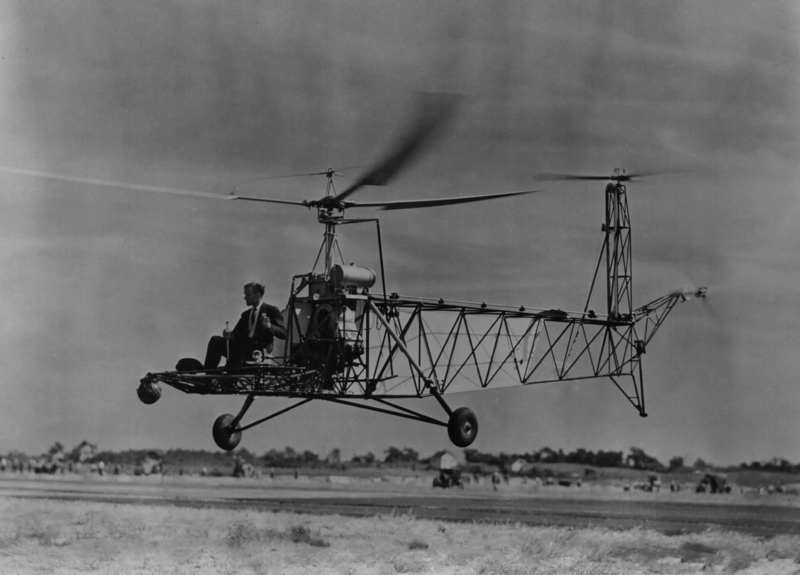 The third VS-300 configuration, piloted by Charles Lester Morris, September 22, 1941. Note the vertical tail structure with a horizontally-mounted rotor for forward and backward movement.
The third VS-300 configuration, piloted by Charles Lester Morris, September 22, 1941. Note the vertical tail structure with a horizontally-mounted rotor for forward and backward movement. The third VS-300 configuration on August 11, 1941, a few days before its first flight on August 14, 1941.
The third VS-300 configuration on August 11, 1941, a few days before its first flight on August 14, 1941. Charles Lester Morris at the controls of the third VS-300 configuration, above the meadow next to the Sikorsky factory.
Charles Lester Morris at the controls of the third VS-300 configuration, above the meadow next to the Sikorsky factory. The third VS-300 configuration in November 1941. A doped cotton fabric skin was added to enclose the cockpit.
The third VS-300 configuration in November 1941. A doped cotton fabric skin was added to enclose the cockpit.
The VS-300 team now had a firm understanding of the control precession issue of the first configuration and made changes to the third configuration’s swashplate to account for it.
The first flight of the third configuration VS-300 occurred on August 14, 1941, with Igor Sikorsky, Serge Gluhareff, and Charles Lester Morris, who was now Sikorsky’s chief test pilot, taking turns flying the aircraft. The performance gains resulting from the third configuration’s design changes were immediately evident to all three pilots. The aircraft was able to achieve speeds of 50 mph in forward flight, stability and control were vastly improved, and the removal of the outriggers from the second configuration resulted in a notable weight savings as well as reduction in parasitic drag. As testing progressed through the Fall 1941, the third configuration VS-300 achieved speeds up to 70 mph and altitudes over 100 feet.
Fourth and Final Configuration
As testing of the second and third configuration VS-300s progressed, the VS-300 team was busy collecting data for the design and construction of a more-capable, two-person helicopter being proposed to the U.S. Army, which eventually became the VS-316A (also known as the S-47 and by its military designation R-4). Igor Sikorsky and VS-316A project manager William Hunt made a decision to reconfigure the VS-300 one last time, as the fourth configuration, to introduce a full cyclic pitch control system to the main rotor that allowed both longitudinal and lateral direction control. As a result, the tail-mounted horizontal rotor of the third configuration was no longer necessary and removed entirely, leaving the helicopter in its single main rotor and single anti-torque tail rotor final configuration.
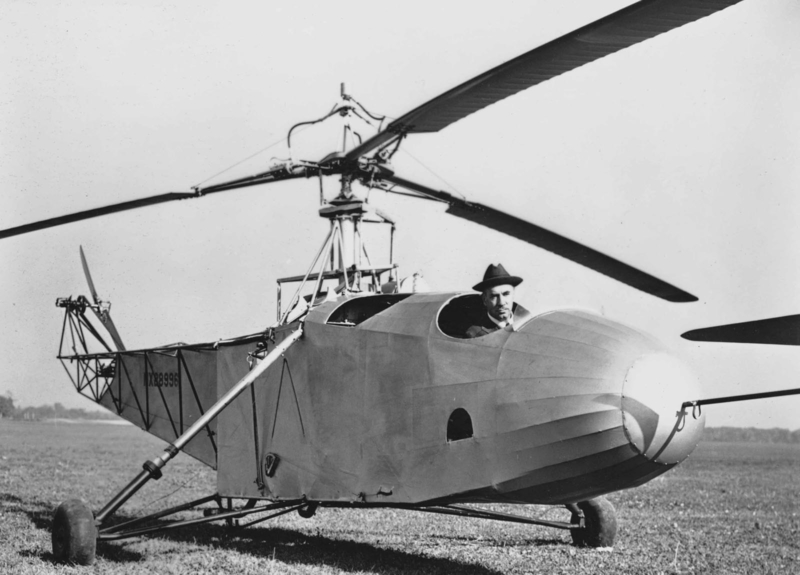 Igor Sikorsky in the VS-300A. Note the small passenger seat added directly in front of the transmission.
Igor Sikorsky in the VS-300A. Note the small passenger seat added directly in front of the transmission. The VS-300A alongside the XR-4, with Igor Sikorsky in the pilot seat, in December 1941.
The VS-300A alongside the XR-4, with Igor Sikorsky in the pilot seat, in December 1941. Igor Sikorsky demonstrating the capabilities of the VS-300A at the Edison Institute (now the Henry Ford Museum of American Innovation), on October 7, 1943.
Igor Sikorsky demonstrating the capabilities of the VS-300A at the Edison Institute (now the Henry Ford Museum of American Innovation), on October 7, 1943.
The first flight of the fourth configuration VS-300, now called the VS-300A, was conducted on December 8, 1941 by Charles Lester Morris. It only flew for a few seconds before the aircraft started shaking back and forth, so he lowered it back to the ground. No immediate solution to the wobble problem was apparent from a post-flight inspection, so over the next few weeks, Igor Sikorsky and the VS-300 team analyzed the root cause of the wobbling, eliminated potential sources on the aircraft and finally determined the source of the problem as the main rotor head. Igor Sikorsky determined that blade dampers installed in such a way to reduce rotor blade oscillation in the horizontal plane would resolve the problem, so the VS-300A’s main rotor system was updated and the aircraft readied for another flight test. On December 31, 1941, Charles Lester Morris carefully lifted the VS-300A into the air and found the shaking problem was eliminated.
Flight testing of the VS-300A progressed into 1942 with the flight control system receiving fine tuning with each flight. During this period, the VS-300A was also updated with a redesigned, lighter tail structure developed by shop manager Alex Krapish.
In October 1942, a 30-foot diameter two-bladed main rotor was installed on the VS-300A and tested. Although it performed well, the vibration levels of the two-bladed system were much higher than that of the original 28-foot diameter three-bladed system. Improvements were made and flight tests continued with the two-bladed system through February 1943; however, the performance of the three-bladed system was still superior so it was reinstalled.
As 1943 progressed, fewer and fewer test flights of the VS-300A were performed as the team increased their focus on the VS-316A flight test program. Igor Sikorsky, with the help of Charles Lindbergh, offered to donate the VS-300A to Henry Ford for display at the Edison Institute (now known as the Henry Ford Museum of American Innovation) in Dearborn, Michigan, and Henry Ford enthusiastically accepted.
In a ceremony in front of the museum on October 7, 1943, Igor Sikorsky and Charles Lester Morris demonstrated the capabilities of the aircraft before he set it down one last time. Throughout all of its four configurations, the VS-300 flew a total of 100 hours and 35 minutes and helped Igor Sikorsky finally solve the questions he had about vertical flight since his first helicopter he developed in 1909 but could not fly, the H-1.
- by Steve Mendrzychowski

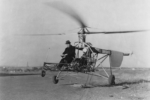
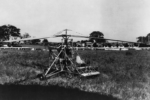
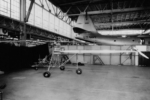
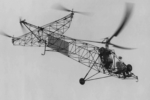
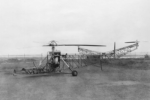
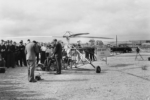
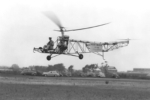
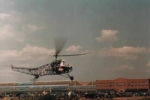
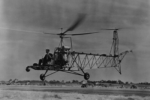
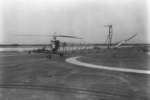
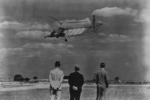
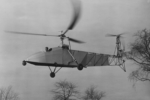
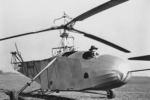
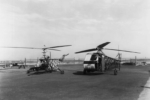
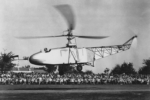
Pingback: [Vídeo] Centenario de Sikorsky en USA - Sandglass Patrol